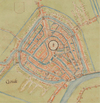Van wie was het stadhuis?
Orde en verstoring in een publiek overheidsgebouw in Gouda en Leiden, ca. 1450-1520
DOI:
https://doi.org/10.51769/bmgn-lchr.12777Keywords:
Town Halls, Urban Governance, Built environment, contestation, late medievalAbstract
In the fifteenth century the town hall was a crowded, public government building in cities in the northern Low Countries. It was a multifunctional building, being an important centre for urban governance and the location for public services. Authorities aimed to regulate access and behaviour in the building, and especially in the court rooms, through built environment, protocols and enforcement. Yet, order in the town hall was not self-evident. By examining statutes and criminal records and using a 3D reconstruction of the public hall and public courtroom, this article shows how disorder in the town hall of Gouda and Leiden was common and contested the order so much desired by local magistrates. Both city officials and other inhabitants purposely used the openness of specific spaces in the town hall to publicly emphasize or contest authority. I argue that the late medieval town hall was shaped by both governmental structures and its daily use by a diverse group of urban dwellers.
Downloads

Downloads
Published
Issue
Section
License
Copyright (c) 2023 Nathan van Kleij

This work is licensed under a Creative Commons Attribution 4.0 International License.
Authors who publish with this journal agree to the following terms:
a) Authors retain copyright and grant the journal right of first publication with the work simultaneously licensed under a Creative Commons Attribution 4.0 International (CC BY 4.0) that allows others to share the work with an acknowledgement of the work's authorship and initial publication in this journal.
b) Authors are able to enter into separate, additional contractual arrangements for the non-exclusive distribution of the journal's published version of the work (e.g., post it to an institutional repository or publish it in a book), with an acknowledgement of its initial publication in this journal.
c) Authors are permitted to post their work online (e.g., in institutional repositories or on their website) prior to and during the submission process.
Authors are explicitly encouraged to deposit their published article in their institutional repository.







